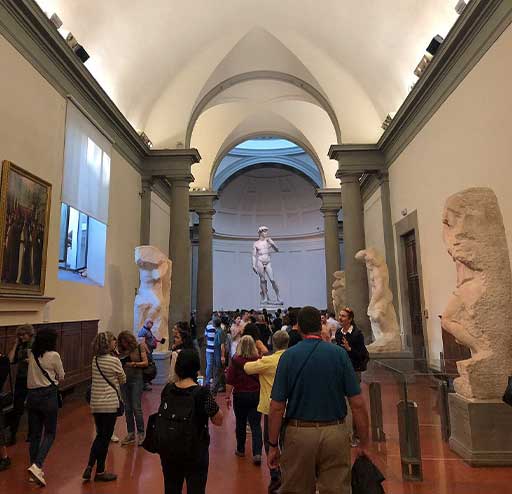6 curiosities about the Accademia Gallery of Florence
The Accademia Gallery in Florence is a museum that is home to some of the world’s most famous works of art. Located in the heart of the city, the museum was founded in the 18th century as an academy for the study of drawing and painting. Today, it is a museum that exhibits a wide range of works of art, including Michelangelo’s sculpture of David and a collection of paintings by artists such as Botticelli and Ghirlandaio.
The Accademia Gallery is located in the former convent of San Giovanni Evangelista, which was acquired by the Italian state in the 19th century. The museum’s collection also includes a number of musical instruments, reflecting the important role that music played in the cultural life of Florence.
Here are six interesting facts about the Accademia Gallery of Florence you might not have known.
Located in the heart of Florence, the Accademia Gallery is home to some of the most famous works of art in the world, including Michelangelo’s sculpture of David. But there is much more to this museum than meets the eye. Here are six curious facts about the Accademia Gallery:
01. The museum was originally founded as an academy for the study of drawing and painting. The Accademia di Belle Arti di Firenze, or “Academy of Fine Arts of Florence,” was established in 1784 by Pietro Leopoldo, Grand Duke of Tuscany. It was not until later that it became a museum and began exhibiting works of art. The transition to a museum happened in the 19th century when the academy’s collection of plaster casts and the original works of art it held were made available for public viewing.
02. The Accademia Gallery is home to more than just Michelangelo’s David. The museum also houses a collection of plaster casts of famous sculptures, including works by ancient Greek and Roman artists. In addition to the plaster casts, the museum has a collection of paintings by artists such as Botticelli, Ghirlandaio, and Perugino. These paintings were mostly created in the 14th and 15th centuries and depict religious and mythological themes.
03. The museum was originally located in the Medici family’s palace, but it was moved to its current location in 1873. The palace, known as the Palazzo dell’Accademia di Belle Arti, was deemed too small to accommodate the growing collection of the academy. The museum was then moved to the former convent of San Giovanni Evangelista, which had recently been acquired by the Italian state. The new location provided more space for the museum’s exhibits and allowed for the inclusion of more works of art.
04. The museum is home to several other Michelangelo sculptures, including the Four Slaves, which were originally intended for the tomb of Pope Julius II. The Four Slaves, also known as the Prigioni, are four unfinished sculptures that were created by Michelangelo in the early 16th century. They were intended to be part of the Pope’s tomb, but the project was never completed. The Four Slaves can be found in the museum’s Michelangelo room, along with other sculptures by the artist.
05. The Accademia Gallery is not the only museum in Florence that houses Michelangelo’s David. A copy of the sculpture can also be found in the Piazza della Signoria. The copy, which was made in the 19th century, was placed in the piazza in order to protect the original David from damage caused by the elements. The original David can be found in the Accademia Gallery, where it is protected from the elements and can be viewed by the public.
06. The museum’s collection also includes a number of musical instruments, including a harpsichord that was built for Grand Duchess Anna Maria Luisa de’ Medici. The harpsichord, which was made in 1720 by the famous instrument maker Bartolomeo Cristofori, is one of several musical instruments that are part of the museum’s collection. Other instruments in the collection include violins, violas, and cellos. The inclusion of these instruments in the museum’s collection reflects the importance of music in the cultural life of Florence.

